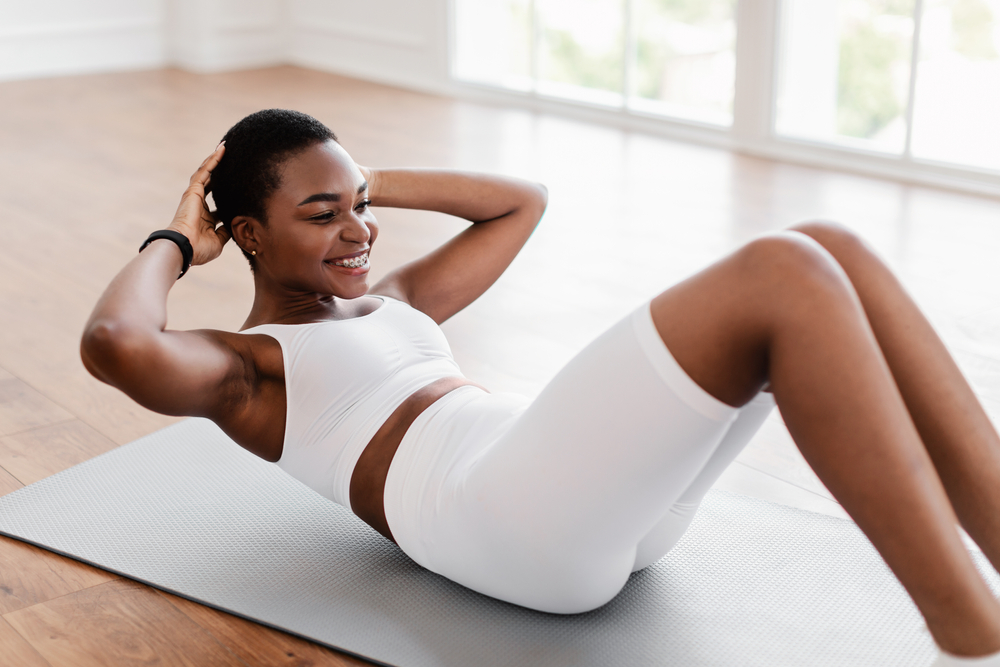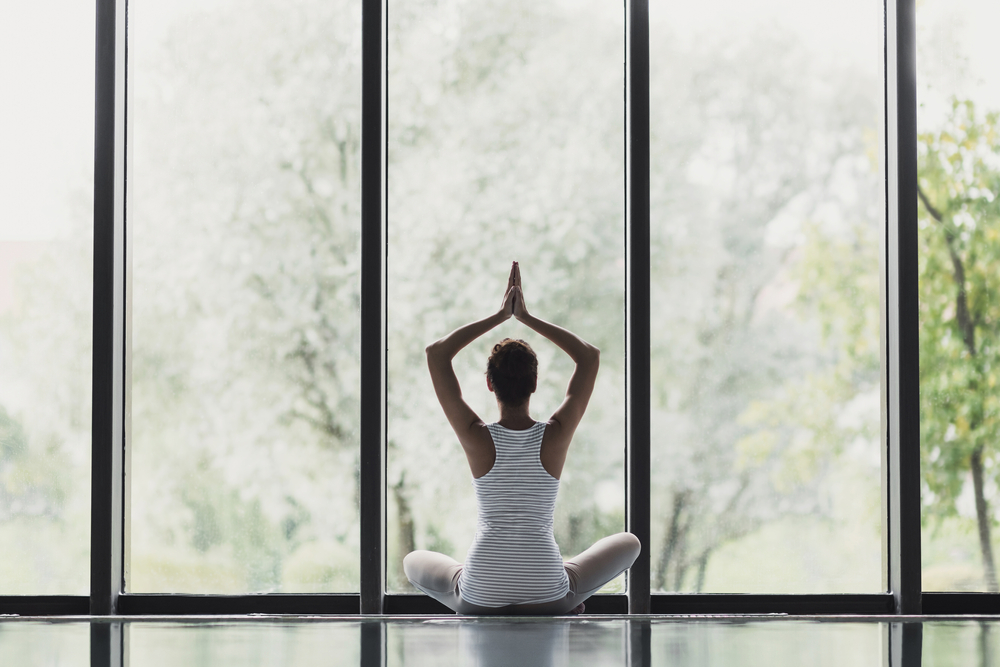DISCLAIMER: Always consult with a healthcare professional before starting any new routines, programs, or nutrition plans to ensure you receive the best medical advice and strategy for your specific individual needs.
Our guess is, if you’re on this page reading about diastasis recti abdominis, you’re somewhat aware of what this condition entails. It’s a common condition that affects many people, especially postpartum women.
Diastasis recti abdominis occurs when the abdominal muscles separate, causing a gap between the left and right sides of the rectus abdominis muscle. This condition can cause physical and emotional challenges, and recovering from it is not always easy.
As with many things concerning our physical and emotional health, it can take time and patience to get through it.
So let’s look closer at what diastasis recti abdominis, who it affects, and how to deal with it.
What Causes Diastasis Recti?

In most cases, during pregnancy, the growing uterus can put pressure on the abdominal muscles, causing them to stretch and separate. Hormonal changes during pregnancy can also cause the connective tissue that holds the muscles together to become more relaxed, making it easier for the muscles to separate. In some cases, vaginal delivery can also cause the condition.
In addition to pregnancy, other factors that can contribute to diastasis recti include:
– Obesity or rapid weight gain and loss
– Poor posture, particularly a posture that pushes the belly out
– Improper lifting techniques or heavy lifting
– Chronic coughing or sneezing
– Abdominal surgery, such as a C-section or hernia repair
It’s important to note that not everyone who experiences these factors will develop diastasis recti.
Some people may be more predisposed to the condition due to genetics or other factors. It’s also possible to have a mild degree of diastasis recti without experiencing any symptoms or complications.
Who Does Diastasis Recti Abdominis Affect?
 Are women more prone to suffer from diastasis recti abdominis? Yes, women are more prone to suffer from diastasis recti abdominis than men, particularly during and after pregnancy. The condition affects about 60% of pregnant people. This is because, during pregnancy, the growing uterus puts pressure on the abdominal muscles, causing them to stretch and separate. Hormonal changes during pregnancy can also cause the connective tissue that holds the muscles together to become more relaxed, making it easier for the muscles to separate.
Are women more prone to suffer from diastasis recti abdominis? Yes, women are more prone to suffer from diastasis recti abdominis than men, particularly during and after pregnancy. The condition affects about 60% of pregnant people. This is because, during pregnancy, the growing uterus puts pressure on the abdominal muscles, causing them to stretch and separate. Hormonal changes during pregnancy can also cause the connective tissue that holds the muscles together to become more relaxed, making it easier for the muscles to separate.
However, this abdominal muscle separation can also happen to men and women who have gained and lost a significant amount of weight. Factors that can contribute to diastasis recti include obesity or rapid weight gain and loss, poor posture, improper lifting techniques or heavy lifting, chronic coughing or sneezing, and abdominal surgery, such as a C-section or hernia repair.
While diastasis recti abdominis isn’t necessarily harmful, it’s a health condition that is frequently not taken seriously enough, although it causes discomfort and contributes to lower back pain, pelvic instability, and poor core strength. It can even impact daily activities like lifting and exercising. Not to forget, it can take an emotional toll, affecting self-esteem and body image.
What Is the Difference Between Diastasis Recti And a Hernia?

Diastasis recti and a hernia are two different conditions, although they can have similar symptoms and may sometimes be confused.
As we’ve established, diastasis recti is a condition where the abdominal muscles separate along the midline, causing a gap between the left and right sides of the rectus abdominis muscle. Its symptoms include a protruding belly, back pain, and poor posture. Diastasis recti abdominis is not considered a serious medical condition, although it can cause discomfort.
A hernia, on the other hand, occurs when an internal organ or tissue bulges through a weak spot in the abdominal muscles. The most common type of hernia is an inguinal hernia, which occurs when a portion of the intestine bulges through the inguinal canal in the groin area. Symptoms of a hernia may include a bulge or lump in the affected area, pain or discomfort, and a feeling of weakness or pressure. Hernias can be serious if left untreated, as they can cause complications such as obstruction or strangulation of the affected organ or tissue.
The main difference between diastasis recti and a hernia is that a diastasis recti is a separation of the abdominal muscles, while a hernia is a protrusion of internal organs or tissue through a weak spot in the abdominal muscles. While they can have similar symptoms, they are two distinct conditions that require different treatments. If you suspect that you have either diastasis recti or a hernia, it’s important to speak with a healthcare provider for an accurate diagnosis and appropriate treatment.
Most Common Symptoms of Diastasis Recti

The primary symptom of the condition is the visible bulge or ridge that runs down the midline of the abdomen. It’s particularly noticeable when the person is performing an activity that puts pressure on the abdominal muscles, like sitting up, coughing, or sneezing.
Other symptoms of diastasis recti abdominis include:
– A protruding or “pooching” belly that does not flatten with exercise or diet
– Lower back pain or discomfort
– Poor posture or a “swayback” appearance
– Difficulty performing certain movements, such as sit-ups or crunches
– Digestive issues, such as bloating or constipation
– Pelvic floor dysfunction or incontinence (in severe cases)
If you can relate to any of the above symptoms best is to consult with a healthcare professional and start your treatment to avoid any future complications. Your recovery will most likely be separated into two parts–physical and emotional. Here is what the physical recovery includes.
Physical Recovery from Diastasis Recti Abdominis
When it comes to recovering from diastasis recti abdominis, physical rehabilitation plays a crucial role. This part of your journey can be divided into several key tasks–education, guidance, physical therapy, personalized treatment plan, and physical exercises.
Knowing how to approach your physical recovery is arguably the most important step in your recovery. It’s crucial to learn about the condition understand and how it affects your body. In this step, you should focus on researching safe and effective exercises, as well as modifications, so that you can gradually include exercises and help your body heal.
Seeking guidance from a healthcare professional or physical therapist can also provide valuable support and insight, and create a plan that is tailored to your specific needs. The knowledge a physical therapist has will ensure you don’t include exercises or movements that exacerbate your condition.
In this video, you will learn more about how to tell if you too have diastasis recti.
Whether you choose to work with a healthcare professional or pursue exercises on your own, it’s important to listen to your body and progress at a pace that feels comfortable for you. Recovery from diastasis recti abdominis takes time, so pace yourself and don’t push too hard.
Here are a few exercises that you might find helpful on your physical recovery journey.
Exercises to Help You Alleviate Symptoms of Diastasis Recti Abdominis
 These routines will help you strengthen your abdominal muscles and if you do them consistently close the gap caused by diastasis recti.
These routines will help you strengthen your abdominal muscles and if you do them consistently close the gap caused by diastasis recti.
-
Belly breathing
Begin by lying on your back with your knees bent and your feet flat on the floor. Place one hand on your belly and one hand on your chest. Take a deep breath through your nose, allowing your belly to expand. Exhale slowly through your mouth, gently contracting your abdominal muscles to bring your belly button toward your spine.
This video should help you get started:
-
Pelvic tilts
For this exercise, lie on your back with your knees bent and your feet flat on the floor. Slowly tilt your pelvis upward, pressing your lower back into the floor. Hold for a few seconds, then release.
Here’s a video of the pelvic tilts exercise to help you get it right:
-
Abdominal Bracing
This exercise involves lying on your back with your knees bent and your feet flat on the floor. Inhale deeply, then exhale and gently draw your belly button in towards your spine. Hold for a few seconds, then release.
In this video, you’ll see an example of the abdominal bracing exercise:
-
Transverse Abdominis Engagement
For this exercise, lie on your back with your knees bent and your feet flat on the floor. Take a deep breath in, then exhale slowly while gently contracting your pelvic floor muscles and pulling your belly button toward your spine. Hold for a few seconds, then release.
Here’s a video to help you with the transverse abdominis engagement exercise:
-
Bird dog
Here you start on your hands and knees with your wrists directly under your shoulders and your knees directly under your hips. Extend your right arm and left leg straight out, keeping your hips level. Hold for a few seconds, then switch sides.
This video should help you get started with bird dog:
-
Modified Plank
This exercise involves starting in a modified plank position, with your forearms and knees on the floor. Engage your core muscles and hold the position for 30 seconds to 1 minute, keeping your back flat and your hips level.
Here’s a video example of the modified plank:
-
Dead Bug
For this exercise lie on your back with your knees bent and your feet flat on the floor. Raise your arms towards the ceiling, and lift your legs so that your knees are over your hips. Slowly lower your right arm and left leg towards the floor, keeping your core engaged and your lower back pressed into the floor. Return to the starting position and repeat on the other side.
Here’s how to do the dead bug exercise:
-
Seated Russian Twist
For the Russian twist, sit on the floor with your knees bent and your feet flat on the floor. Hold a weight or medicine ball in front of your chest, and twist your torso to the right, tapping the weight on the floor beside your hip. Return to the starting position and repeat on the other side.
Here’s a video to help you with the seated Russian twist exercise:
Remember, start with low-intensity exercises and gradually increase the intensity as your abdominal muscles become stronger. Listen to your body and stop any exercise that causes pain or discomfort.
Note that not all exercises are suitable for everyone with diastasis recti. A qualified physical therapist can help you create to understand your specific case and customize an exercise plan that is appropriate for your individual needs and goals.
Emotional Recovery from Diastasis Recti Abdominis

Recovering from diastasis recti abdominis is not only about physical rehabilitation but also emotional recovery. Coping with this condition can be challenging, so here are some important steps you can take to support your emotional well-being during the recovery process.
The Importance of Self-Care
Self-care is crucial during the recovery process. Taking care of your physical and emotional needs can help you feel more empowered and in control. Self-care can involve a variety of activities, such as getting enough sleep, eating a healthy diet, engaging in activities you enjoy, and seeking social support. Practicing self-care can help you feel more resilient and better able to cope with the challenges of recovering from diastasis recti abdominis.
Avoiding Self-Judgment
It’s important to avoid self-judgment and be kind to yourself during the recovery process. Diastasis recti abdominis can be a difficult and frustrating condition to deal with, but it’s important to remember that everyone’s journey is different.
Instead of judging yourself for how long it takes to recover or comparing yourself to others, focus on celebrating your progress and accomplishments. Practicing self-compassion and self-love can help you develop a more positive relationship with your body and support emotional healing.
Mindfulness & Stress-Reduction Techniques
Stress can hurt the body’s ability to heal. Practicing mindfulness and stress-reduction techniques, such as meditation, deep breathing, or yoga, can help reduce stress levels and promote relaxation.
These techniques can also help you develop a more positive mindset, which can support emotional healing and recovery.
The Benefits of a Wellness Retreat for Diastasis Recti Recovery

A wellness retreat can offer a safe and supportive environment to help you focus on your recovery. These retreats typically provide access to specialized resources and professionals, as well as a community of others who are also recovering from diastasis recti abdominis. This can help you feel less alone and more supported as you navigate the challenges of recovery.
Access to Specialized Resources and Professionals
A wellness retreat may offer access to specialized resources and professionals, such as physical therapists, nutritionists, and other healthcare providers. This can provide valuable guidance and support as you work to recover from diastasis recti abdominis.
Supportive Community and Personalized Care
Attending a wellness retreat can also offer you a supportive community of people who are going through similar experiences. This can help you feel less isolated during the recovery process. Additionally, many wellness retreats offer personalized care and attention to meet your individual needs.
Relaxation and Stress-Reduction Opportunities
Wellness retreats often provide opportunities for relaxation and stress reduction, such as meditation, yoga, or massage. These activities can help promote overall well-being and support emotional healing.
On a Closing Note

Recovering from diastasis recti abdominis is a journey filled with both emotional and physical healing. Connecting with professionals, exploring specialized resources, and joining a supportive community are all powerful tools to help you foster positivity, provide healing strategies and bring about greater self-acceptance.
It’s vital to know that your well-being takes priority. So, give yourself the necessary compassion throughout your journey as you engage in mindful practices, develop self-care strategies, and take advantage of the personalized care at a dedicated wellness retreat.
In any case, don’t be afraid to ask for help when needed, it’s a crucial part of your recovery process!
DISCLAIMER: Always consult with a healthcare professional before starting any new routines, programs, or nutrition plans to ensure you receive the best medical advice and strategy for your specific individual needs.


 By Team THOR
By Team THOR
